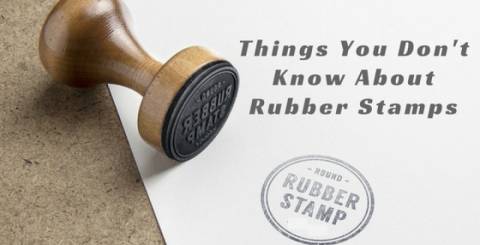6 Things We Bet You Don't Know About Rubber Stamps

Rubber stamps are pretty much integrated into our lives, regardless of whether they are used for business or for hobbies and activities like scrapbooking. One doesn’t really question the convenience it brings us, or it’s widespread popularity amongst users of all ages. However, there is more to rubber stamps apart from it’s useful nature or cost effective benefits.
If you would like to know more, here are 6 interesting facts you may not have known about rubber stamps:
Invention Source
When it comes to who exactly invented rubber stamps, the whole subject remains a controversial one. There were disputes on the actual inventor of the first rubber stamps. An individual by the name of L.F. Witherell, who resided in Knoxville (Illinois), is said to have claimed to be the inventor of the rubber stamps in 1866. He states that the discovery is made by fixing rubber markings and letters to the end of a bedpost with the intention of marking wooden pumps that were made with identifications. Yet despite so, they were never able to produce landmarked bedposts or other forms of evidence to sufficiently reveal that he is the actual inventor.
Then there’s James Orton Woodruff who resides in New York. He borrowed a vulcaniser from his uncle, who happened to work as a dentist. He is said to have claimed that the stamps and items that he has used for image printing remains, while the rubber portion were ruined by ink, which has contained solvents. There are of course other claimants who sought to claim to have invented the rubber stamps but of all who had attempted to do so, these two distinguished individuals have left the most credible sources.
Earliest Uses
It is discussed that some of the earliest uses of stamps have actually been discovered by Native Americans, who use them as a means to mark patterns onto their body for tattooing at a later stage. Even before rubber stamps were mass manufactured for use, there have been primitive versions of these rubber stamps around. They were used and made by hand in various different countries, with India being one of them. In India, primitive stamps are actually created with mud to mold shapes! The molded shapes are then decorated with colouring using other ingredients so that they can be stamped on different materials. Some cultures also took to making deep and more intricate impressions on thick layered hide, since they are resilient like rubber.
Unexpected Connections
One of the most surprising facts about rubber stamps is that it’s history can be said to have been closely connected with the field and industry of dentistry. This is because an invention created in the field of dentistry has actually ended up assisting with rubber usage in dentistry mould bases. It turns out that the small vulcanisers that have been popularly used by dentists of the time are actually ideal to mass produce rubber stamps!
Manufacturing Differences
Most individuals tend to assume that the rubber stamp manufacturers they go to and commission to customise their rubber stamps are the ones who made the product to completion. In actual fact, rubber stamp manufacturers are not the ones that are tasked with producing the elements required to create rubber stamps directly from their raw source. The raw materials are actually created by others known as specialty manufacturers with the purpose of supplying them to the rubber stamp makers for further assembly and use!
Materials Used
Since most business owners opt to go for ready made rubber stamps instead of unmounted rubber stamps, it can be difficult to understand how the actual process goes. The materials rubber stamp makers used are actually comprised of separate raw elements like latex rubber, mounting blocks of their choice (mostly acrylic or wood), adhesive backing for sticking and labels.
Byproducts or Waste
For the environmentally concerned, you will be pleased to find out that rubber stamps actually contribute to little waste, even when it comes to the manufacturing process. The manufacturers are trained to arrange and lay out rubber sheets in a manner that can minimise the amount of scrap material they will get. The remainings of rubber trimmings or adhering material left are therefore very little. Even if the design is continued or business owners no longer need to use the rubber stamps, they can actually choose to donate them to organisations or hospitals for crafting purposes!
Similar Articles
Good leadership is a feature of such a person that they think of the whole team and not only themselves. Leadership is your behaviour, not your status by title.
In the world of civil construction, a small mistake can have a big impact. Whether it’s delays, budget overruns, or safety issues, the costs of poor staffing are often overlooked until it’s too late.
Learn how to choose winning products for your dropshipping website with smart research, trend analysis, and testing tips for better profits.
In today’s fast-growing lighting industry, LED strip lights have become one of the most popular solutions for modern lighting design.
Discover how partnering with a software developer recruitment agency can prevent burnout in development teams and enhance project sustainability.
Learn how corporate event catering boosts image, fosters networking, reduces stress, and creates memorable experiences at professional gatherings.
Discover essential commercial HVAC maintenance strategies to cut costs, boost efficiency, and ensure comfort for employees and customers.
Maximize your corporate mentoring program's impact. Discover best practices for strategic implementation to foster growth and development.
Strong bookkeeping turns financial chaos into clarity, guiding smarter decisions, ensuring compliance, and building long-term business stability.









